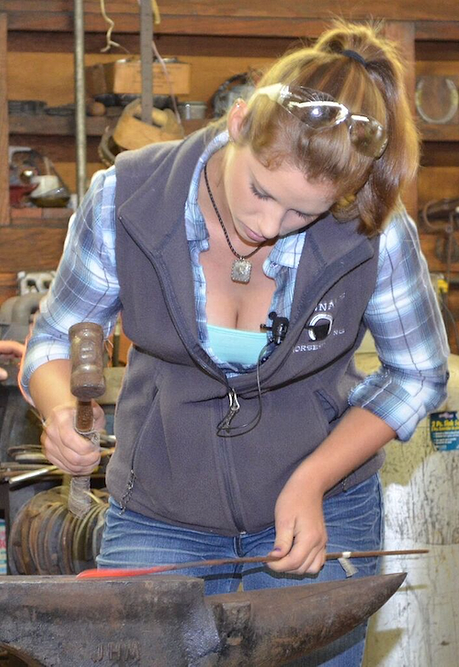Pictured Above: Figure 1. Hannah Simms begins forging a rose from bar stock. At a white heat she flattens 5 inches at the end to about 1/8 inch.
Farrier Hannah Simms demonstrated some simple ornamental blacksmithing techniques during Danny Ward’s Eastern Farrier Conference in early November of 2015. The Statesboro, Ga., farrier says that mastering the techniques involved not only helped improve her hammer control, it has also provided her with a nice source of additional income.
While attending Danny Ward’s Horseshoeing School in Martinsville, Va., Simms became interested in an exercise that involved forging small, ornamental roses from a piece of bar stock. Ward recalls her spending hours of her own time practicing the technique.
“She would be out in the shop during the evenings forging roses when a lot of the students would be going to a bar or doing something else,” says Ward.
Skill Refining
Simms says there are benefits to learning the process beyond making something pretty.
“It helped me a lot with my hammer skills,” she recalls. “To do certain steps, such as making the stem or adding a leaf, takes really fine hammering. Flattening out the metal works best with overlapping blows, so the entire time you’re flattening, you’re practicing hammer control.”
During the November demonstration, it took Simms about 45 minutes to finish the job. When she isn’t stopping to explain the process, she can finish a rose in about 30 minutes. That’s a far cry from when she started.
 Figure 2. Simms cuts petals into the edges of the flattened area. She starts at the tip, forming smaller petals and then widens them slightly as she moves down the stock.
Figure 2. Simms cuts petals into the edges of the flattened area. She starts at the tip, forming smaller petals and then widens them slightly as she moves down the stock.
“It used to take me about an hour and a half,” says the Statesboro, Ga., shoer. “It took me about a month of trying before I made what I considered my first ‘pretty’ one, and about 2½ to 3 months to get to a point where I could do that consistently.
The Rose-Making Process
Simms used quarter-inch cold rolled round stock for most of her roses. The step-by-step process involves.
- She starts out with about 18 inches of stock and at a white heat, flattens the 5 inches at the end to about 1/8 inch (Figure 1).
- At an orange heat and using a hardie, she cuts petals into the flattened area (Figure 2). She starts at the tip, forming smaller petals and then widens them slightly as she moves down the stock. She finds 11 to 13 petals make the best rose. Once the petals are formed, she returns the stock to the anvil and flattens them out a little more, using the round side of her hammer for added definition.
-
Using a needle-nosed pliers, she turns the petals back onto themselves to form the rosebud (Figure 3). This takes a fine touch, as the metal being worked with is very thin.
 Figure 3. Simms uses needle-nosed pliers to turn the petals back onto themselves to form the rosebud.
Figure 3. Simms uses needle-nosed pliers to turn the petals back onto themselves to form the rosebud.
- The stem of the rose in formed at the base of the petals. She says this can be done before or after the petals are formed. Depending on the purpose of the rose, the stem can be anywhere from 2 to 6 inches long. If you’re making a shorter stem, take care in placing your tongs and making sure you don’t hit the fragile petals with hammer blows.
- Simms sometimes adds a leaf to the stem (she didn’t do that at this particular clinic). To add a leaf, she cuts about ¾-inch of unthinned stock at the end of the stem. She heats up the area and draws it out to a point, using the round part of the hammer to hit the widest part of the drawn-out section until it’s the size she wants. She uses a hammer or a chisel to draw veins down the center and to the sides of the leaf.
- Simms makes many of her roses as an ornament for a key chain. For these, she adds a loop where the key ring can be attached. For this step, she advises putting the key ring into the loop before closing it to make sure the key ring will slide through the loop.
Popular Items
 Simms with a completed rose.
Simms with a completed rose.
Simms started making her roses as gifts for family member, but soon discovered there was a market for them. She set up a blacksmith stand at a local corn maze on weekends and started making her roses and other items, such as barbecuing utensils, and offering them for sale. She gets anywhere from $15 to $30 for a rose, depending on the size and complexity. She says that most are bought as gifts and they’ve become her biggest selling item.









Post a comment
Report Abusive Comment